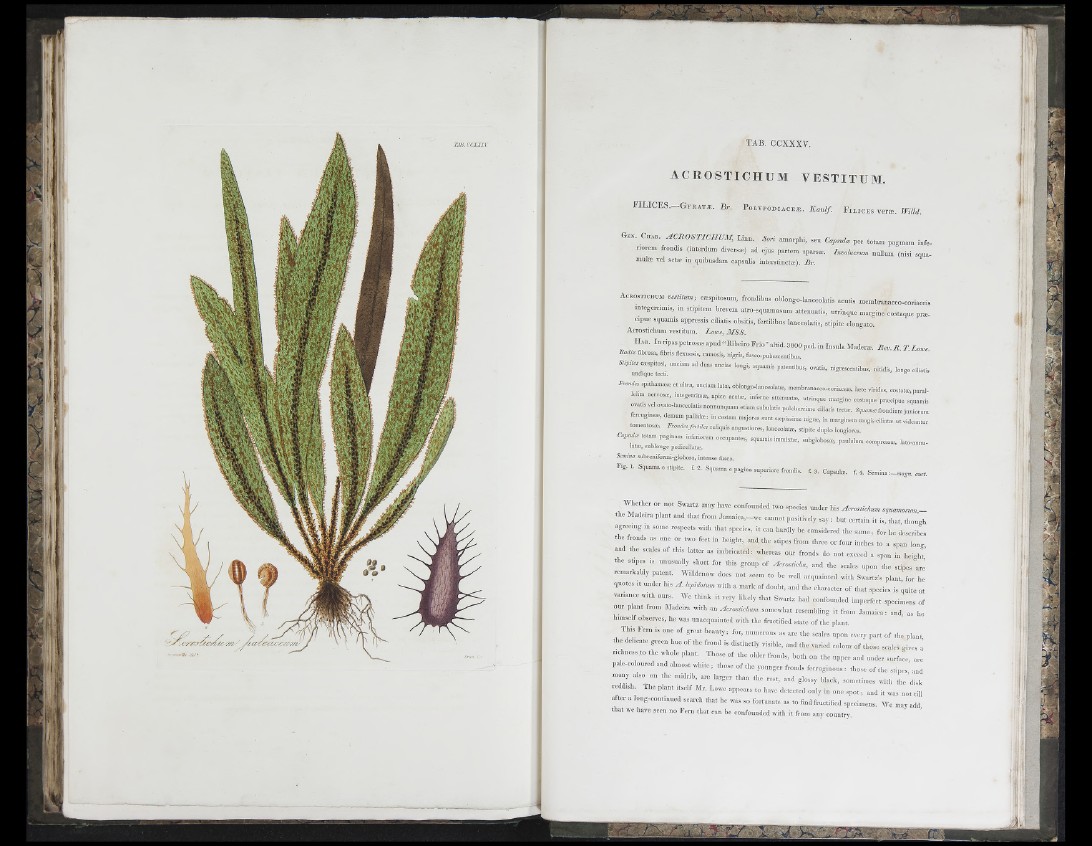
t a b . c c x x x v .
A C R O S T I C H UM V E S T IT UM.
F I L I C E S . - G v e a t æ . B r . PoiYPODiAOEÆ. K a u l f . F i l i c e s v e ræ . W illd .
Gen . C h a e . A C R O S T I C H U M , Linn, io n ' am o ip h i, seu Capsuloe per .„ lam pagmam i„ fe -
n o iem froudis {iulerdum diversæ) ad ejus partem sparsæ. Involucrum „„Hum (nisi squa-
mulæ ve l setæ in quibusdam capsulis interstinctæ). B r .
A c e o s t ic u u m vc stUum; cæspitosum, frondibus oblongo-lanc eolatis a cu ti, membrauaeeo-corlaeeis
.u teg e rnm is, ... stipitom brevem atro-squamosum atten u a ti,, utrinque margine costaque præ-
cipuc squamis appressis ciliatis obsitis, fertilibus lanceolatis, stipite e lougato.
Acrostichum vestitimi. Loiue, M S S .
H a u . In rlpas p e tro sa , apud "Ribeiro Frio" altid. 3 0 0 0 ped. in Insula Maderæ. R e v . R . T. L ow e
Radix fibrosa, fibris flexuosis, ramosis, nigris, fusco-pubescentibus.
“ “ ¿ i long, ciliatis
Frovdcs spithamææ c . altra, uuciam la.æ, obI„„g<A,a„«o.a,æ, membranacec-cori.ccæ, læ.c virides, costatæ, p.rai-
lebm uervosæ,, .„tegerrimæ, ap.ee acutæ, iuferue .ttc .u .tæ , utra.que margiu. costaque præcipae squamis
ovaus vel ovato-lauceolatis „ „.„„„„.au, etiam subaiatis puicherrime ciliatis tectæ. S,»a„,æf,-„„di„m jaaioram
errugmcæ, emum p.ll.dæ : m costam majores sunt ampissime nigræ, in marginem magis ciliatæ ut videantnr
tomentosæ. Frobesfertiles reliquis angaslior.s, lanceolatæ, stipite duplo longiores.
CapsaM tolaia paginam ¡„feriorem occupantes, squami, immixtæ, sabglobosæ, p.°aloI„m compressæ, I.to-aaaa-
latæ, sublonge pedicellatoe.
Semina subrenifonni-globosa, intense fusca.
F ig .I . Squama .stipite, f . 2. Squama e pagina superiore frondis. f. 3. Capsnlæ. f . 4. Semina aari.
Wh e th e r or n o t Sivnrtz may I.ave confounded two species under h is Aorostichum squ am osum -
the M.adeira plant aud that from J am a ic a ,-w e c a n ..« p o sitively s a y , but certain it is, th a , thou’gh
agreemg ... som e respects with that sp ecies, it can hardly be considered the sam e , for he describes
th e fronds as one or two fe e t in l.c lg l.t, aud the stip e , from three or four inches to a span lon g
aud the scales o f th.s latter as imbricated: whereas our fronds do n o t exce ed a span in h e ig h t’
th e s .,PCS is unusually short for „ .is group o f Aoroslioha, and the scales upon the stipes ate’
lemarkably patent. W .lld cu ow does n o t see .u to be well .aequaluted with Swartz's plant for he
quotes ,t under Ins A . lepido.um with a ...ark o f doubt, and the character o f that species is lu it e a ,
v a r ..„ e e with ours. Wo th in k i , vety lik e ly that Swartz had coufouuded iu .p e tfce , specimens o f
on , plant from Madc.ra w.tl. ms A orostichum somewhat resembling it from Jamaica: and, as he
liim se if observes, he was imacquaiiitecl with the fructified state o f the plant.
This Feru is one o f great b eau ty , for, as .are the scales upon every par, o f the plant
the del.cate green hue o f the frond is distiuetly visible, and the varied colour o f „ .o s e scales gives a’
r ,clmess to the whole plaut. T h o se o f ,l.c older fronds, both o „ the upper aud under surface are
pale-coloured aud almost white : th ose o f the younger fronds fcrruginons : those o f the stip e s’ and
many also on the midrib, arc larger than tl.c rest, and g lo ssy black, someti.nes with t h e ’disk
reddish. Th e plant „ s e lf Mr. Lowe appears to have detected only in one s p o t ; and it was n o , till
after a lon g -con t.n n ed search tb a , he was so fortunate as to find fructified specimens. W e may add
tliat we have seen no Fern that can be confounded with it from any country.
I a
. . à .